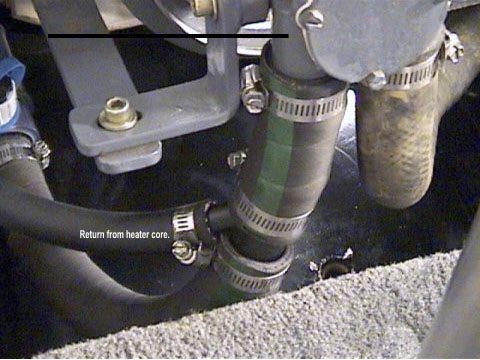I've used those for the last six seasons. Super convenient for early and late quick drains when temps drop below the comfort zone. I do also disconnect the raw water line from the lower end of the tranny cooler. Good luck.
I've used those for the last six seasons. Super convenient for early and late quick drains when temps drop below the comfort zone. I do also disconnect the raw water line from the lower end of the tranny cooler. Good luck.
Yeah, and since I've been looking into this, I've found the "Y" modification where you put the heater core inlet between the raw water intake and your fresh water pump because I guess it circulates water better when the engine is idling. In this case, I would think I could put a "drain" port on the line where the heater core outputs water and use that as a place to blow water in (which would push air into the heater core and in turn push the heater core water out the fresh water intake...
It works in my head anyway... I think I'd chat with Skidim a little to be sure since they know a lot about the Heater Craft Y-fitting...

2008 Moomba Mobius XLV. Monster Cargo Bimini, and more mods to come...
1992 Supra Sunsport. **SOLD** 2k pounds ballast, Surf System, Blue LED's everywhere, decent audio system.
Tow Rig: 2013 F150 Ecoboost FX4 (wife's rig) Other money pits include:1998 BMW M3 Cabriolet, 2002 Audi S6 Avant, 2005 Kawasaki ZX-6R 636.
I used to live on the lake and used the boat daily, even in winter. I tried the block valves, but they tend to get plugged from the scale that flakes off inside the block. I went back to just removing the plugs. Once the water drains, put them right back in and you won't have an issue with corrosion.
Agreed on the scale or deposits from inside the risers being there, but a simple ream from a small piece of 12 or 14 gauge wire with the valves open (engine running) clears them just fine. I clear them 3-4 times a season and am grateful for them when it's 75 at noon and 30 at night in June. Engine drain with hose disconnect takes 30 seconds. Once a season I make sure they move ( unmount freely) without disconnecting them and don't miss the bloody knuckle I used to get from the riser plug. Good luck.
I use those valves, and I do agree that they get clogged easily. They are a good way to get most of the water out though. And if one is clogged, you can use the wire method mentioned by steamboat above, or just take that one out and clean it, then replace it right away. That's about the same as pulling the plug to begin with, and you may not have to do it.
I also have that y-pipe right before the raw water pump and it definitely helps the heater crank out hot air at idle speed. The only drawback is that when the heater is drained, it makes it harder to get the system pumping water properly because it pulls air into the impeller until the heater core is really filled with water. Which I often have to do by pulling the hose from the block to the heater, holding it up high and filling it with water from a cup (usually an empty beer can honestly). I put some clear hose in that section (heater to y-pipe) so I can see air bubbles.
This all applies for a "quick winterize" that I'd do for the boat if it was going to be a cold night or something. With temps of -20F in the winter, I pump antifreeze through everything after draining and replacing plugs / closing valves, when I'm done with the boat for the season. For the OP, I guess I'd be ok with the valves if you watch carefully to be sure each opening is draining well when you open it up. It's good to open them at the lake or whatever (on the trailer obviously), then tow it home with them open so the engine gets tipped at different angles, too - more opportunity for any puddles of water to get sloshed out. And yeah the heater is very sensitive and full of loops of piping that will crack, so you'll have to blow that out. I've tried a few different systems of draining the heater, including places to put compressed air in, and really nothing beats just pulling the hose at both ends and blowing it through. Kinda sucks but it's reliable and easy. The best (simplest) mechanical air system I used was a rechargeable pump made for an air mattress, with a little hose attached to the stem on the pump. But I would always have to have that with me, and still had to pull the hoses; it's easier just to use my lungs.